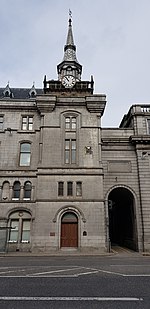Aberdeen Maritime Museum
Maritime museums in ScotlandMuseums in AberdeenUse British English from February 2018

Aberdeen Maritime Museum is a maritime museum in Aberdeen, Scotland. The museum is situated on the historic Shiprow in the heart of the city, near the harbour. It makes use of a range of buildings including the former Trinity Congregational Church, which was converted to be used as an extension of the museum, and Provost Ross' House, one of the oldest domestic buildings in the city.The museum tells the story of the city's long relationship with the North Sea. Its collections cover shipbuilding, fast sailing ships, fishing and port history, and displays on the North Sea oil industry.
Excerpt from the Wikipedia article Aberdeen Maritime Museum (License: CC BY-SA 3.0, Authors, Images).Aberdeen Maritime Museum
Shiprow, Aberdeen City City Centre
Geographical coordinates (GPS) Address External links Nearby Places Show on map
Geographical coordinates (GPS)
| Latitude | Longitude |
|---|---|
| N 57.14646 ° | E -2.09496 ° |
Address
Aberdeen Maritime Museum
Shiprow 52-56
AB11 5BY Aberdeen City, City Centre
Scotland, United Kingdom
Open on Google Maps








